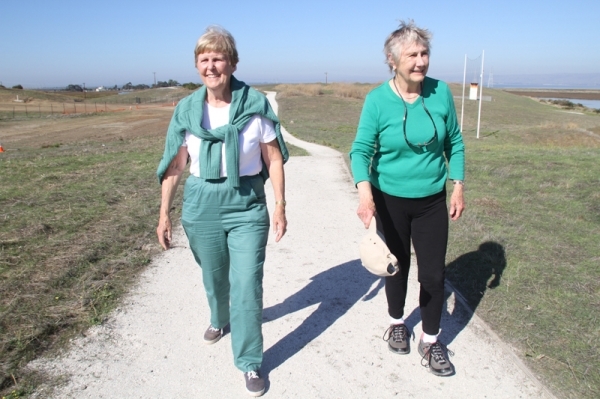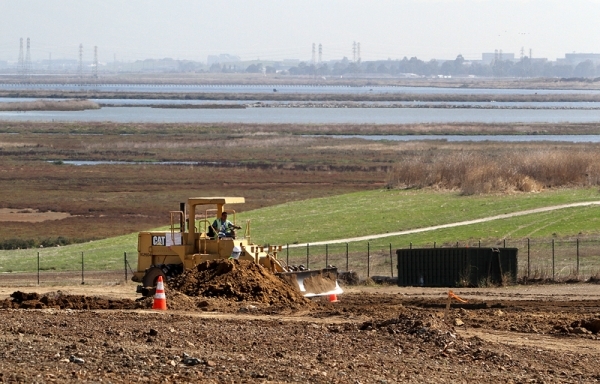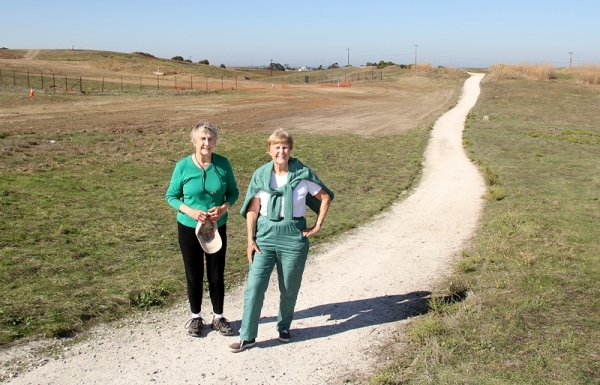The future of Palo Alto's composting services probably won't be settled until at least early 2014 as the city prepares to perform a series of complex studies and survey its options for a possible waste-to-energy plant in the Baylands.
The city this week unveiled an action plan outlining the next steps in one of its most complex and polarizing dilemmas. The issue emerged as a hot topic because of the recent closure of the landfill, which included the city's composting operation.
The Baylands landfill received its final load of yard trimmings on March 31, according to a new report from Charles Muir, an environmental specialist in the Public Works Department.
The landfill's closure means the city will now have to export its yard trimmings to Gilroy. That prospect has galvanized the city's green community, with many residents urging the City Council to keep composting local. Last year, a large coalition of environmentalists succeeded in passing Measure E, an initiative that undedicated 10 acres of Byxbee Park in the Baylands and made them available for an anaerobic digester, a plant that would process local food waste and yard trimmings and convert them into electricity.
The passage of Measure E answered the crucial question of where the new composting operation could be located. But, as Muir's report makes clear, it is prompting many other questions about the costs and impacts of a proposed plant. The staff's action plan includes a long list of complex and expensive homework assignments that the city would have to complete before the council could make the big decision in early 2014 on whether to proceed with the plant.
Those assignments include environmental and financial analyses, a request for proposals from technology companies and the creation of a new "Organics Resource Recovery Strategy" to guide the future of the city's waste operation.
The proposed strategy document would "describe the amounts and types of organic materials that are available for energy/compost and export options, evaluate the current and potential future programs for collecting and conveying organic materials, define the process that will be used for comparing current organics management with the options provided by vendor proposals, and develop the city's strategy for encouraging or discouraging alternative organics management options such as food waste disposers and home composting," Muir wrote.
The proposed action plan underscores the nature of the city's composting dilemma, which is slated to dominate council meetings for at least the next year-and-a-half. Under this plan, the city would immediately start to develop the strategy document and the request for proposals, which would address possible composting technologies as well as options for exporting food scraps and yard trimmings.
Palo Alto would launch its state-mandated environmental analysis for the new plant in July 2013 with the goal of having the study completed by January 2014. The council would then decide in February 2014 whether to build the new waste-to-energy plant or to export its compostable waste.
The analysis won't be cheap. To help meet the action plan's timeline, Public Works staff is asking the council to add $290,224 to its contract with the city's consultant, Alternative Resources, Inc., for a total not to exceed $517,682 in fiscal year 2013.
Some of the city's best-known conservationists, including former councilwomen Emily Renzel and Enid Pearson and land-use attorney Tom Jordan, have consistently opposed the construction of a new plant in the Baylands.
They greeted the proposed action plan with jeers and urged the council not to authorize the increase in the consultant's contract. Renzel, who serves as the coordinator of the Baylands Conservation Committee, ripped the proposed action plan (among other things) for failing to give time for the city's commissions to review the work that would have to be performed at the landfill.
"By approving the budget amendment, the strategic plan and the timeline, you are setting yourselves up for all sorts of crazy decision-making with inadequate information, inadequate environmental review and novel technologies," Renzel wrote in a letter to the council.
Pearson concurred and argued in her letter that Measure E created "a totally chaotic situation wherein the city staff has to guess what needs to be done, to which part of the park, and when."
She also cited the lawsuit that opponents of Measure E filed, questioning the legality of the measure. The judgment, she said, is expected in the middle of September.
"It is imprudent to continue pouring money into a project that might prove to be illegal," Pearson wrote. "The city does not have to act now and can wait a minimum time to make such a critical decision."





Comments
Duveneck/St. Francis
on Jun 29, 2012 at 5:53 pm
on Jun 29, 2012 at 5:53 pm
I find it ironic that the two "best known conservationists" have had their photo taken in a spot that will be inaccessible if the projected sea level rise caused by global warming actually occurs. Web Link has a set of maps if you are curious. It's a mystery to me why any conservationist would find it acceptable for Palo Alto to truck our sewage waste and our green compost to Gilroy thus adding even more carbon dioxide to the overburdened atmosphere, not to mention paying a great deal of money to give away two resources that the city can quite possibly use to our advantage.
The success of Measure E has given Palo Alto an opportunity to do something to convert our compostable wastes to green energy and reduce our green house gas emissions. It also gives Palo Alto a way to control our own waste stream, reduces the city's exposure to dramatic increases in disposal costs and dependence on external waste disposers as well as providing an opportunity to realize income from the composting process. Check out the Palo Alto Green Energy website for additional details: Web Link
A local organization, the Woods Institute for the Environment, is working very hard to provide sustainable alternatives for individuals, organizations and cities. They share their research widely, and gave a seminar in February on Integrated Energy and Resource Recovery from Waste and Wastewater, which has direct bearing on Palo Alto's situation. Take a look.
Stanford Woods Institute for the Environment: Web Link
Energy Seminar: Web Link
Finally, I have been to quite a few meetings where city staff laid out in great detail the many variables affecting the development of Palo Alto's organic waste management action plan. The staff is doing the best it can to be as transparent as possible about the process, and jeering at them is insulting, at best. Although anaerobic digestion of sewage sludge and food waste is being used increasingly around the world as a waste management tool and source of energy, there is no blueprint to follow. Each installation must be developed to meet the needs of the community it serves.
There is more at stake here than ten acres of a former garbage dump and some money. I want my grandchildren to be able to walk in the Bay Lands. I really don't want large areas of Palo Alto to be underwater, not to mention large areas of New England and Manhattan, South East Asia, the Netherlands and many Pacific atolls.
Palo Verde
on Jun 30, 2012 at 5:37 am
on Jun 30, 2012 at 5:37 am
By 2014, it will probably be Compost.
Crescent Park
on Jul 2, 2012 at 11:18 am
on Jul 2, 2012 at 11:18 am
Anonymous Grandmother suggests that all of Palo Alto's baylands will be underwater due to Sea Level rise if the compost facility isn't built on former Byxbee Parkland. There is no question that Sea Level rise is happening, but Granma overstates the impact in the Palo Alto Baylands and also the potential for rescue by the Compost facility.
The projections are, I believe, about 54" of sea level rise by the year 2100. Tides are given in Mean Lower Low Water (MLLW) datum which is 4' below Sea Level. All of the hiking areas in the Palo Alto Baylands are at least Elevation 7' in Sea Level datum or 11' in MLLW datum. Many are much higher. The levees are at 14' Sea Level datum. The highest MLLW tides are currently about 7' so the projected 4.5' rise would bring those to 11.5'. By no means would the entire Palo Alto Baylands be flooded.
We should take Global Warming and Sea Level rise seriously, but we ought to be putting our carbon footprint reduction efforts where they are cost effective and where they can truly make a difference.
Midtown
on Jul 2, 2012 at 6:21 pm
on Jul 2, 2012 at 6:21 pm
>The projections are, I believe, about 54"
Or less than zero, depending on how the models project.
James Lovelock, the guru of the global warming concerns, says that the best approach is nuclear power. Do you agree with Lovelock, Emily? If Lovelock is right, then we should not be wasting our time with compost facilities in our baylands.